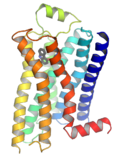Proteins are large biomolecules and macromolecules that comprise one or more long chains of amino acid residues. Proteins perform a vast array of functions...
103 KB (11,472 words) - 16:37, 31 October 2024
Protein–protein interactions (PPIs) are physical contacts of high specificity established between two or more protein molecules as a result of biochemical...
74 KB (8,391 words) - 13:32, 2 November 2024
Proteins are essential nutrients for the human body. They are one of the building blocks of body tissue and can also serve as a fuel source. As a fuel...
46 KB (5,128 words) - 05:45, 5 November 2024
Protein Science is a peer-reviewed scientific journal covering research on the structure, function, and biochemical significance of proteins, their role...
2 KB (103 words) - 23:08, 12 February 2024
Protein A is a 42 kDa surface protein originally found in the cell wall of the bacteria Staphylococcus aureus. It is encoded by the spa gene and its regulation...
17 KB (1,860 words) - 10:05, 20 May 2024
Whey protein is a mixture of proteins isolated from whey, the liquid material created as a by-product of cheese production. The proteins consist of α-lactalbumin...
13 KB (1,453 words) - 05:29, 5 November 2024
transport protein (variously referred to as a transmembrane pump, transporter, escort protein, acid transport protein, cation transport protein, or anion...
4 KB (391 words) - 15:45, 16 October 2024
Protein folding is the physical process by which a protein, after synthesis by a ribosome as a linear chain of amino acids, changes from an unstable random...
76 KB (8,728 words) - 11:37, 6 November 2024
Protein biosynthesis (or protein synthesis) is a core biological process, occurring inside cells, balancing the loss of cellular proteins (via degradation...
40 KB (4,342 words) - 13:04, 6 November 2024
Coat protein may refer to: Viral coat protein, a component of the capsid Variable surface glycoproteins or procyclins, surface coat proteins of either...
557 bytes (110 words) - 17:16, 19 September 2016
A protein precursor, also called a pro-protein or pro-peptide, is an inactive protein (or peptide) that can be turned into an active form by post-translational...
2 KB (280 words) - 18:15, 6 July 2024
Hydrolyzed protein is a solution derived from the hydrolysis of a protein into its component amino acids and peptides. While many means of achieving this...
6 KB (660 words) - 23:56, 16 September 2024
Membrane proteins are common proteins that are part of, or interact with, biological membranes. Membrane proteins fall into several broad categories depending...
18 KB (1,819 words) - 23:55, 25 April 2024
producing proteins that are secreted into the blood, including major plasma proteins, factors in hemostasis and fibrinolysis, carrier proteins, hormones...
5 KB (485 words) - 09:32, 3 August 2023
Protein structure is the three-dimensional arrangement of atoms in an amino acid-chain molecule. Proteins are polymers – specifically polypeptides – formed...
37 KB (4,208 words) - 04:07, 27 October 2024
Protein phosphorylation is one of the most common forms of reversible protein posttranslational modification (PTM), with up to 30% of all proteins being...
21 KB (2,519 words) - 14:43, 22 June 2024
Plasma proteins, sometimes referred to as blood proteins, are proteins present in blood plasma. They serve many different functions, including transport...
6 KB (565 words) - 07:50, 7 June 2024
Protein toxicity is the effect of the buildup of protein metabolic waste compounds, like urea, uric acid, ammonia, and creatinine. Protein toxicity has...
29 KB (3,588 words) - 08:01, 23 October 2024
G protein-coupled receptors (GPCRs), also known as seven-(pass)-transmembrane domain receptors, 7TM receptors, heptahelical receptors, serpentine receptors...
82 KB (9,384 words) - 16:34, 5 September 2024
fibrous proteins or scleroproteins are one of the three main classifications of protein structure (alongside globular and membrane proteins). Fibrous...
3 KB (321 words) - 12:12, 26 September 2024
transmembrane protein is a type of integral membrane protein that spans the entirety of the cell membrane. Many transmembrane proteins function as gateways...
21 KB (2,262 words) - 15:51, 18 July 2024
molecular chaperones are proteins that assist the conformational folding or unfolding of large proteins or macromolecular protein complexes. There are a...
29 KB (3,499 words) - 07:16, 20 February 2024
A protein family is a group of evolutionarily related proteins. In many cases, a protein family has a corresponding gene family, in which each gene encodes...
15 KB (1,571 words) - 13:41, 4 September 2024
In cell biology, protein kinase A (PKA) is a family of serine-threonine kinase whose activity is dependent on cellular levels of cyclic AMP (cAMP). PKA...
27 KB (2,665 words) - 17:03, 6 April 2024
measurements of grams of protein per 100 grams of food portion. The reduction of water content has the greatest effect of increasing protein as a proportion of...
5 KB (423 words) - 00:47, 19 August 2024
of proteins. Understanding protein–protein interactions is important for the investigation of intracellular signaling pathways, modelling of protein complex...
25 KB (2,915 words) - 08:44, 9 May 2024
polypeptide chain. Protein complexes are a form of quaternary structure. Proteins in a protein complex are linked by non-covalent protein–protein interactions...
25 KB (2,841 words) - 17:04, 19 May 2024
A secretory protein is any protein, whether it be endocrine or exocrine, which is secreted by a cell. Secretory proteins include many hormones, enzymes...
4 KB (529 words) - 06:02, 29 April 2024
Pea protein is a food product and protein supplement derived and extracted from yellow and green split peas, Pisum sativum. It can be used as a dietary...
19 KB (2,396 words) - 18:45, 12 July 2024
A protein superfamily is the largest grouping (clade) of proteins for which common ancestry can be inferred (see homology). Usually this common ancestry...
24 KB (2,519 words) - 19:24, 3 September 2024

















